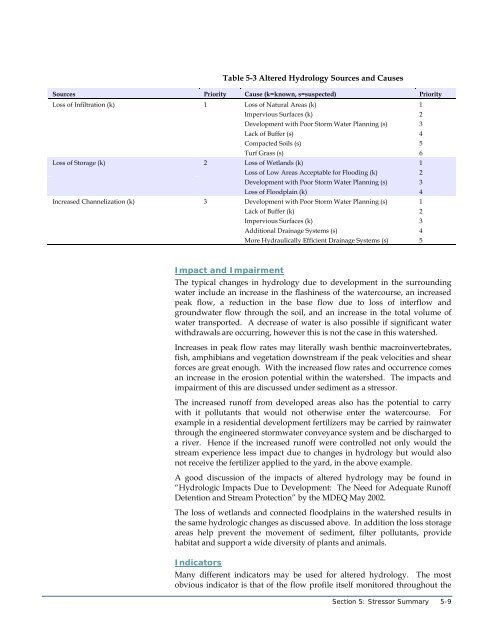Looking Glass River Watershed Management Plan - Greater ...
Looking Glass River Watershed Management Plan - Greater ...
Looking Glass River Watershed Management Plan - Greater ...
Create successful ePaper yourself
Turn your PDF publications into a flip-book with our unique Google optimized e-Paper software.
Table 5-3 Altered Hydrology Sources and Causes<br />
Sources Priority Cause (k=known, s=suspected) Priority<br />
Loss of Infiltration (k) 1 Loss of Natural Areas (k) 1<br />
Impervious Surfaces (k) 2<br />
Development with Poor Storm Water <strong>Plan</strong>ning (s) 3<br />
Lack of Buffer (s) 4<br />
Compacted Soils (s) 5<br />
Turf Grass (s) 6<br />
Loss of Storage (k) 2 Loss of Wetlands (k) 1<br />
Loss of Low Areas Acceptable for Flooding (k) 2<br />
Development with Poor Storm Water <strong>Plan</strong>ning (s) 3<br />
Loss of Floodplain (k) 4<br />
Increased Channelization (k) 3 Development with Poor Storm Water <strong>Plan</strong>ning (s) 1<br />
Lack of Buffer (k) 2<br />
Impervious Surfaces (k) 3<br />
Additional Drainage Systems (s) 4<br />
More Hydraulically Efficient Drainage Systems (s) 5<br />
Impact and Impairment<br />
The typical changes in hydrology due to development in the surrounding<br />
water include an increase in the flashiness of the watercourse, an increased<br />
peak flow, a reduction in the base flow due to loss of interflow and<br />
groundwater flow through the soil, and an increase in the total volume of<br />
water transported. A decrease of water is also possible if significant water<br />
withdrawals are occurring, however this is not the case in this watershed.<br />
Increases in peak flow rates may literally wash benthic macroinvertebrates,<br />
fish, amphibians and vegetation downstream if the peak velocities and shear<br />
forces are great enough. With the increased flow rates and occurrence comes<br />
an increase in the erosion potential within the watershed. The impacts and<br />
impairment of this are discussed under sediment as a stressor.<br />
The increased runoff from developed areas also has the potential to carry<br />
with it pollutants that would not otherwise enter the watercourse. For<br />
example in a residential development fertilizers may be carried by rainwater<br />
through the engineered stormwater conveyance system and be discharged to<br />
a river. Hence if the increased runoff were controlled not only would the<br />
stream experience less impact due to changes in hydrology but would also<br />
not receive the fertilizer applied to the yard, in the above example.<br />
A good discussion of the impacts of altered hydrology may be found in<br />
“Hydrologic Impacts Due to Development: The Need for Adequate Runoff<br />
Detention and Stream Protection” by the MDEQ May 2002.<br />
The loss of wetlands and connected floodplains in the watershed results in<br />
the same hydrologic changes as discussed above. In addition the loss storage<br />
areas help prevent the movement of sediment, filter pollutants, provide<br />
habitat and support a wide diversity of plants and animals.<br />
Indicators<br />
Many different indicators may be used for altered hydrology. The most<br />
obvious indicator is that of the flow profile itself monitored throughout the<br />
Section 5: Stressor Summary 5-9





